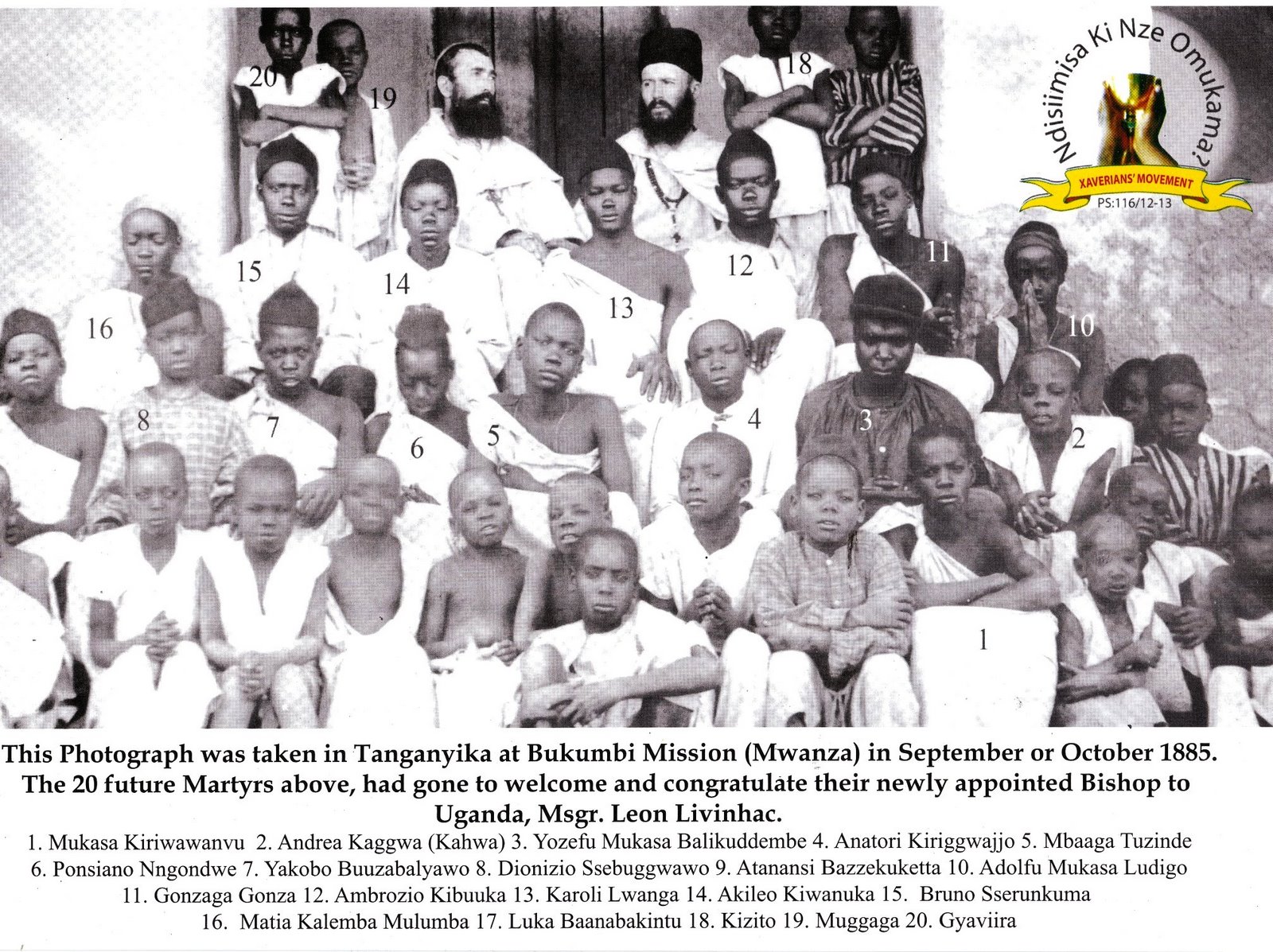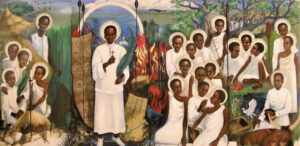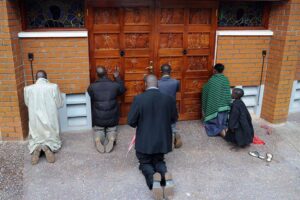
St. Charles Lwanga and companions were martyrs for purity during Christian persecution in Uganda.
CHRISTIANITY COMES TO THE KINGDOM OF BUGANDA
In the early1880s, Christian missionaries entered the Ugandan Kingdom of Buganda, and were welcomed by King Mutesa. They were especially successful with the young people, many of whom served as pages in the king’s court. However, the missionarie’s presence was perceived as a threat by some chiefs and they were driven out. The catechists continued to actively live the Faith, despite an environment where polygamy, drunkenness, marauding, and sexual perversion were commonplace. After the death of Mutesa, his eighteen year old son, Mwanga became king. He invited the missionaries to return in the summer of 1885, and he gave them some land for a mission. Joseph Mkasa was his major-domo or chief steward, and he was the leader of the Christians, faithfully teaching the boys and young men he directed.
CONDUCT CONTRARY TO THE FAITH
The young king, however, was a man of many vices, including alcoholism. He was bi-sexual, and had a particular penchant for adolescent boys. His repeated lewd advances toward the boys caused Joseph Mkasa to protect the pages from the king’s advances. This already raised the ire of the king, but when Mkasa protested the king’s execution of a Protestant minister, he was beheaded on November 15, 1885 at age twenty six. Just before his death, he forgave the king but called for his repentance. By now, the king had an active hatred of the Christians. Charles Lwanga succeeded Mkasa as major-domo. He and his charges knew that they would likely face death at the hands of the king, but they went to the mission to seek Baptism, and Lwanga continued to teach them the Faith and to hide them from the advances of the king.
THE KING ORDERS DEATH

Near the time of Easter of 1886, the priests at the mission learned that a plan was being made for the execution of the Christians, so they sent word for them to avoid the mission. The pages who were not Christian exhorted the Christians to run and hide, but they were resolute and ready to face death for their adherence to the Faith. The king demanded that they renounce their faith and they refused. One night in late May, he summoned the chiefs and the executioners and had the royal compound securely locked. The Christian pages gathered together to pray, while drumbeats went on through an entire night. Charles baptized five of the young pages. The king summoned them all, separating the Christians from the pagans. He ordered the death of the Christians by being burnt on a pyre. They were to march, single file, with ropes around their necks. The execution was to take place at Namugongo, and about sixteen miles from the palace. Namugongo was a place known for ritual sacrifice on the top of a hill. During the march, the Catholic priest from the mission, Father Lourdel, went to King Mwanga to plead for the lives of the young men, and when he was refused, he begged to join them in the march to death, but was again refused. The group of condemned included more than thirty young men, three of whom were killed during the march in order to intimidate on-lookers. At Namugongo, the condemned were tossed into huts, where they prayed continuously and the oldest ones encouraged the younger prisoners. On June 3, the condemned were taken out to the pyre, which was slowly burning. Charles, as the leader, was singled out for the most cruel punishment by the chief executioner. He was slowly burned to death, praying and exhorting his executioner to become Christian and cease opposing God. That executioner, named Senkole, actually did become a catechumen. The remaining prisoners were stripped, rolled in mats, and thrown on a large flaming pyre. Amazingly, one young man was inexplicably pardoned at Namugongo, and he provided an eyewitness account of what transpired. In all, thirty-two, aged thirteen to twenty-five, were put to death that day.
LEGACY AND A SHRINE

The Ugandan Martyrs were willing to face torture and a horrible death, rather than recant their new-found faith and fidelity to the truths and teachings of the Catholic Faith. The fruits of this mass martyrdom were abundant. In less than eighty years, the number of Catholics in Uganda had grown from several hundred to two million. Twenty-two young men and boys were canonized by Pope [St.] Paul VI in 1964 as the Martyrs of Uganda. There is a shrine built in their memory at Numagongo, near the Ugandan capital of Kampala. The list of the martyrs includes: Sts. Charles Lwanga, Joseph Mkasa, Matthias Mulumba, Denis Ssebuggwawo, Andrew Kaggwa, Pontian Ngondwe, Athanasius Bazzekuketta, Mbaga Tuzinde, Gonzaga Gonza, Noah Mawaggali, John Mary Muzeyi, Luke Banabakintu, James Buzabaliawo, Bruno Serunkama, Mugagga, Kizito, Mukasa Kiriwawanvu, Gyavira, Adolph Ludigo, Anatole Kiriggwajjo, Ambrose Kibuka, and Achilles Kiwanuka. The feast day of the Ugandan martyrs is June 3.
